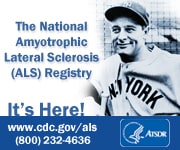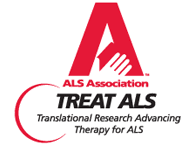Saturday, February 28, 2009
A New Gene for ALS
In today’s issue of the journal Science two papers describe the discovery of a new gene for ALS (you can read the abstracts here and here). 95% of ALS cases are sporadic, i.e. we don’t know what causes them, but for 5% of patients the disease runs in their family (known as familial ALS, FALS). Until today, there was only one major causative gene that we knew about, called SOD1, which accounted for 20% of familial cases. Today’s new discovery of the gene FUS (also known as ALS6) accounts for an additional 5% of familial cases and was the result of an international collaboration between scientists in Boston, London, and Sydney. This is very exciting for research because the more we know about what causes ALS, the better our chances of finding an effective treatment through better understanding of the pathways involved in motor neuron degeneration.
Here at PatientsLikeMe, we’ve recently upgraded our ALS platform to capture data on familial ALS patients’ known genetic mutations. The goal is to help familial ALS patients find another patient like them, and to enhance understanding of the phenotype of each mutation, e.g. if different types of mutation cause a faster or slower disease progression. Ultimately our aim is to try and establish whether there might be any treatments that have a differential effect on patients with different disease-causing mutations. There are examples of this already known in other diseases; for instance the presence of absence of the Philadelphia chromosome in chronic myelogenous leukemia (CML) predicts whether the patient will respond to the drug Gleevec. Although there is currently only a single effective treatment for ALS (Rilutek), there are a number of trials underway investigating the potential of drugs for patients with specific gene mutations.
source & data Patients Like Me
Friday, February 27, 2009
Researchers identify ALS gene mutation - Type 6
CHICAGO --- Research that has discovered a new gene whose mutations cause 5 percent of inherited cases of ALS (amyotrophic lateral sclerosis) is part of a national study led by the Northwestern University Feinberg School of Medicine.
The study reported in Science today (Feb. 27) points to a common cellular deficiency in the fatal neurological disorder, said Teepu Siddique, M.D., Les Turner ALS Foundation/Herbert C. Wenske Foundation Professor in the Davee Department of Neurology and Clinical Neurosciences and Department of Cell and Molecular Biology and Director of the Division of Neuromuscular Medicine at the Feinberg School.
The new research is part of a national collaboration directed by Siddique, the principal investigator for the "Genetics of ALS" project funded at Feinberg by the National Institutes of Health.
Earlier research by Siddique and colleagues extended the genetic knowledge of familial (inherited) ALS by identifying the first and second ALS genes (the SOD1 gene in 1993 and the ALSIN gene in 2001), in addition to identifying loci on chromosomes 9, 15, 16, and X.
The study published today discovered aFUS/TLS gene mutations in ALS families collected through efforts of the NIH-funded multi-center project and included among others a large Italian family previously studied by Siddique and Cortelli.
ALS affects the motor neurons in the central nervous system. As motor neurons die, the brain's ability to send signals to the body's muscles is compromised. This leads to loss of voluntary muscle movement, paralysis and eventually death from respiratory failure. The cause of most cases of ALS is not known.
"The purpose of this national study is to understand what triggers the death of motor neurons in order to find new cellular models of ALS, with the ultimate goal of advancing research that leads to a treatment for this fatal disease," Siddique said. "Approximately 10 percent of ALS cases are inherited."
"The discovery of this gene mutation shows new kinds of molecular defects that damage motor neurons and it implicates defective pathways previously identified in other genetic forms of ALS," said Siddique.
The new findings were reported in Science by the University of Massachusetts Medical School, one of three institutions that collaborate with Siddique on the national study. Other authors from the consortium include M.A. Pericak-Vnace (University of Miami and Jonathan Haines (Vanderbilt University). Robert H. Brown Jr., M.D., chair and professor of neurology at University of Massachusetts Medical School, was senior investigator of the study and lead author of the Science paper.
In addition to funding from the NIH, Siddique's ALS research is supported by the Les Turner ALS Foundation, Vena E. Schaff ALS Research Fund, Harold Post Research Professorship, Herbert and Florence C. Wenske Foundation, Ralph and Marian Falk Medical Research Trust, The David C. Asselin MD Memorial Fund, Les Turner ALS Foundation/Herbert C. Wenske Foundation Professorship, Help America Foundation and the ALS Therapy Alliance, Inc.
source & data;Les Turner ALS Foundation
Thursday, February 26, 2009
The Art Of Fundraising Vs. The Science Of Curing A Disease

Monday, February 23, 2009
Dandruff Steals The Headlines... Besides, You're Not Likely To Have This Disease
From Dr. Donohue's "To Your Good Health" column at www.southcoasttoday.com ... way under the featured question on dandruff...
DEAR DR. DONOHUE: My father was 67 when he passed away in 1989 from ALS, Lou Gehrig's disease. He had it for only two years. I am 60 years old and a Vietnam veteran from 1968. I had extensive nerve and muscle wounds in both legs and my left arm from the war. I get muscle spasms in my legs and am concerned that it might be ALS. Is ALS hereditary?
— B.W.
Only in a few cases, 5 percent to 10 percent, does heredity play a major part in ALS. ALS is amyotrophic lateral sclerosis. It's a dying off of nerve cells in the brain and spinal cord that control muscle movement. In its final stages, it leaves a person a prisoner of his own body, unable to move and often unable to swallow or talk. The initial symptom of ALS is muscle weakness, not muscle spasms. You're not likely to have this illness.
Readers may write to Dr. Donohue or request an order form of available health newsletters at P.O. Box 536475, Orlando, FL 32853-6475.
Dr. D's response is correct from the textbook. The part that is missing is that since veterans have an astronomically increased risk of ALS, perhaps B.W. might want to touch base with a VA neurologist to check out whatever his problem may be.
"You're not likely to have this illness," is a sentence that thousands of people with ALS have heard from primary care physicians before being diagnosed correctly by knowledgeable neurologists.
Friday, February 20, 2009
Support Stem Cell Research
Not for much longer. Millions of Americans and hundreds of millions more worldwide who have been afflicted by fatal or terminal illnesses can actually begin to imagine, they can hope. They can dream of the incurable becoming cured.
Contact President Obama and urge him to remove the current restrictions which limit stem cell research. With your help, we can ensure that the ALS research community can pursue every opportunity to find a treatment and cure for Lou Gehrig's disease as soon as possible.
Welcome, at last, to the 21st century.
Take Time and Take Action.
Sunday, February 15, 2009
Disease For Sale By Owner... Or At Least Foreclose On It And Get It Out Of Our Lives
 Every year the National Association of Realtors has its mid-year meeting in Washington, DC, in May. It's like the ALSA advocacy conference and day except it's bigger, and, well... they're Realtors. This year they'll be hungry Realtors.
Every year the National Association of Realtors has its mid-year meeting in Washington, DC, in May. It's like the ALSA advocacy conference and day except it's bigger, and, well... they're Realtors. This year they'll be hungry Realtors.In the past ALS advocates have sometimes hit Capitol Hill on the same day as the Realtors. Those highly tagged, badged, and pinned brokers and salespeople are not a shy lot. They are there in droves. They fill up elevators and legislators' offices. They know how to make sales, and they seem to be driven to get to legislators at all costs. They glance at ALS advocates' nametags, but the cause is hard to read. They see people in wheelchairs and think about that accessible property they have back in Anytown, USA.
You may wonder why in the world Realtors want (and seem to get) so much face time with our legislators. You may wonder why Realtors approach legislators so aggressively and relentlessly. What could they possibly have to talk about? We have a matter of life and death to discuss. What drives relentless Realtors to Washington?
Take a look at the stimulus package. That answers the questions. There are some incredible incentives to get the housing market moving and to sell that accessible property in Anytown. Cha-ching.
The people in the wheelchairs at the backs of the elevators need to be heard, too. The competition is stiff. The Realtors got what they wanted.
Saturday, February 14, 2009
Change We Need

http://capwiz.com/alsa/attachments/ALS_Association_NIH_Transition_Statement_FINAL_Attachement_.pdf
"Over the past six years, funding for the NIH has been flat and, in recent years, funding for ALS research through the NIH has decreased."So we're not even been treading water relative to NIH priorities?









